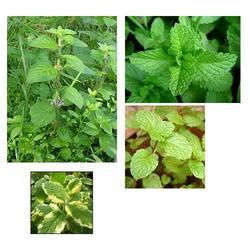Mentha Arvensis (Pudina, Mint)

Biological Name:
Mentha arvensis, Menthae haplocalycis
Family:
Labiatae
Other Names:
Mint, Marsh mint, Pudinah, Puttiyana, Chetni-maragu, Wild Mint or Corn Mint, Bo he, Chinese mint.
Habitat:
It is a native of northern and western Himalayas and Kashmir and cultivated in gardens in Konkan.
Additional Info:
It is Dıpana (stimulates digestion), Anuloma (redirects the flow of vata downwards), Svedana (diaphoretic) and Sirovirecana (cleanses the orifices of the head)
Elements Applied:
Leaves are commonly used in herbal medicine.
Active Components:
It contains a stearoptin known as menthol or peppermint.
Used For :
- It is an Aromatic, Carminative, Stimulant, Antispasmodic, Stomachic and Emmenaagogue.
- It is very good for stomach bloating, hiccups, indigestion, flatulence, irritable bowel syndrome, ulcers, nausea, and anorexia (Bartram 1995). Specific for pitta inflammation and irritation causing gastritis and enteritis. The aromatic essential oils cool the heat of pacaka pitta and regulate samana vayu. This can help to alleviate morning sickness, vomiting and spasms in the gastrointestinal tract.
- Commonly used as a hot tea at a high dose to cause sweating in colds and flu. As mint moves upwards and outwards it is especially useful where ama blocks the pores and they need opening. It is useful where the lungs are congested with catarrh and constricted by spasm, causing wheezing or asthma (Frawley & Lad 1994).
- It normalises the flow of prana vayu all over the body. By moving upwards and outwards it spreads any congested vata blocked from whatever cause; ama, kapha, high vata or high pitta. The high levels of the space element(akas´a tattva) present within peppermint with its expansive nature moving upwards and outwards opens the mind and lifts the ‘heaviness’ of mental and emotional tension and constriction. It opens spaces and creates room for movement.
- Peppermint water as an external spray is excellent for cooling and soothing skin inflammation, hot flushes and allergic itching (Tillotson 2001).
- It acts as a diaphoretic- clears wind-heat conditions associated with colds and influenza with fever, headache, sore throat, and red eyes (conjunctivitis).
- Often combined in formulas that help the flow of vata in the lower abdomen and ease menstrual congestion, pain and amenorrhoea (Frawley & Lad 1994).
- Moreover, it is considered effective for mild cases of hives, allergy rashes, toothaches, and mouth ulcers.
Safety:
1-4 masha (1-4 gm) per day can be taken safely (Bhavaprakasha Nighantu). Exercise care. Herbs in Ayurvedic medicine are commonly mixed with other herbal medicines to reduce the toxic effect one of them may produce on the body.
Contact Us
Govind Madhav Herbal Tea
B 29-30, Hari Nagar,, Delhi - 110064, India
Call Us : View Mobile Number
Phone : +91-11-45615006
E-mail : govindmadhavtea@gmail.com
